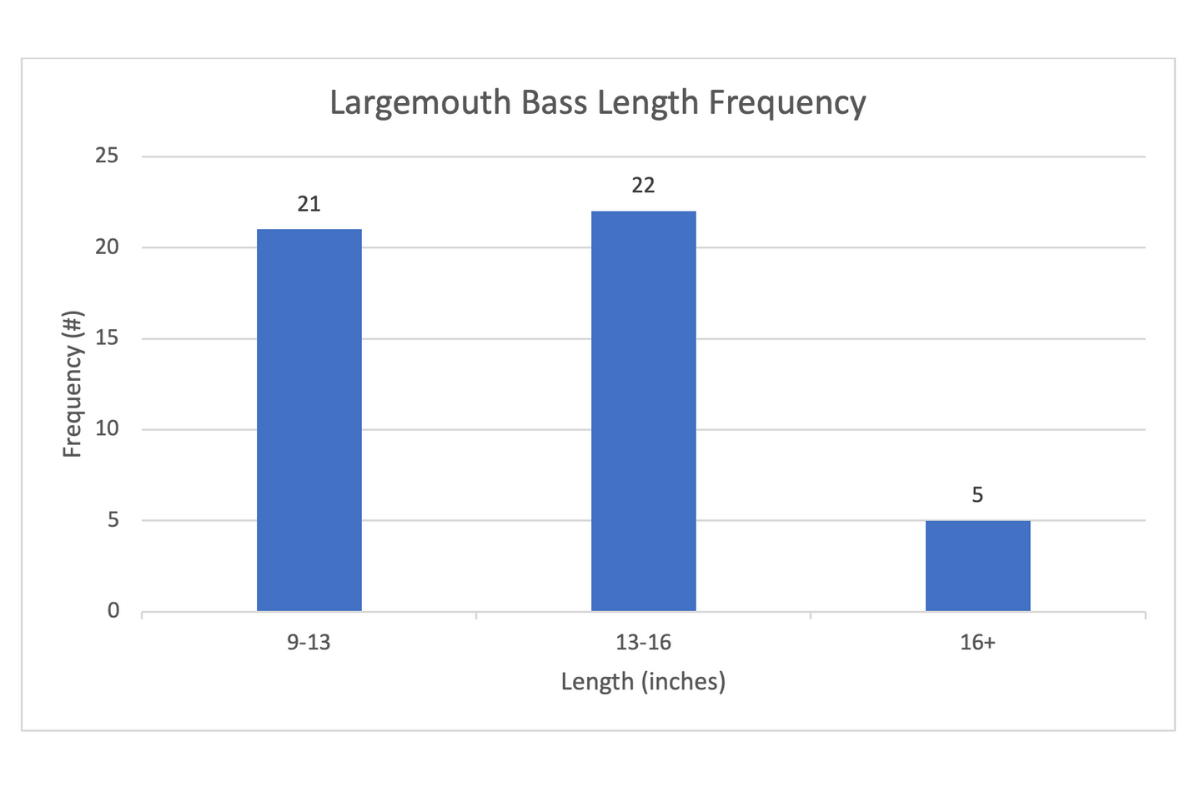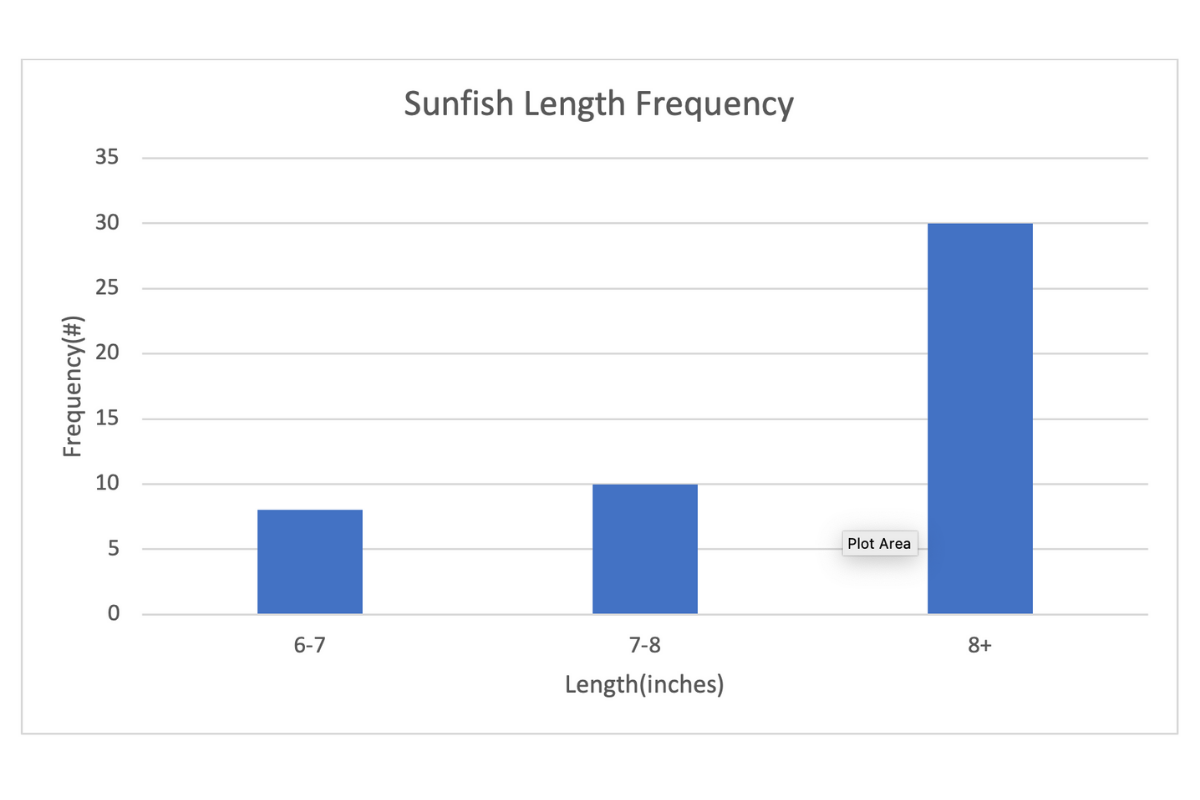Creating a trophy largemouth bass fishery requires a comprehensive, well-rounded approach where all factors that affect the growth of the bass population are considered. There are many factors that might contribute to a stunted largemouth bass population in a pond. These would include overcrowding, lack of prey, and lack of access to prey to name a few. While the lack of growth could be a result of a single factor, the problem is most often a combination of many of these.
Overcrowding of the largemouth bass population is one of the most prevalent problems we see in small and large ponds. This is usually due to the fact that there is not enough removal through fishing. As a result, the average length of the population will decline over time as there are too many bass and not enough resources for them all to eat and grow properly.
In April 2021, we conducted a comprehensive evaluation of a 25 acre farm pond. The goal for this pond was to promote and maintain a well-balanced population of sportfish including largemouth bass and sunfish. The owner specifically wanted the pond to be able to grow “trophy” bass, in addition to maintaining a high level of water quality over the long term.
Water Quality and Vegetation Analysis
Our water testing yielded the following results:
- Alkalinity – 20 ppm
- Hardness – 16 ppm
- pH – 7.1
- Dissolved oxygen – 7 ppm
Most of these water quality measurements are within the range that we find in a healthy pond, although the alkalinity and hardness numbers are on the edge of the minimum threshold we would recommend. The water clarity was measured to be 34 inches, which is exceptional. Usually we are comfortable with a visibility of 18-24 inches.
Little to no vegetation was present in this pond, which is expected in a large farm pond. Due to the significant amount of fertilizer runoff that farm ponds receive, they usually have a strong population of plankton which shades and prevents any invasive vegetative weeds from thriving.
Electrofishing Survey Results
During our electrofishing survey, we collected the following species:
- Largemouth Bass
- Bluegill
- Redear Sunfish (shellcracker)
- Threadfin Shad
- Golden Shiner
- Lake Chubsucker
We did also notice several schools of threadfin shad during the electrofishing process. Of the fish we obtained through electrofishing, we collected length and weight measurements for 48 largemouth bass, 12 bluegill, and 34 redear sunfish.

We collected approximately 100 lbs total of largemouth bass, which ranged from 9.5″ to 19.25″ in length. The weight of individual fish ranged from 0.37 lbs to 3.33 lbs. The sunfish (bluegill and shellcracker) ranged from 6.75″ to 9.75″ and weighed 3.4 ounces to 12.5 ounces. The figures above and below represent the frequency of the largemouth bass and sunfish populations as a function of length, respectively.

Our data suggests that this pond is in an overall state of imbalance and is bass-crowded. There are too many bass competing for a limited amount of prey, and their overall growth is suffering as a result. Our recommendations for improving the bass and sunfish populations in this pond are listed below.
Recommendations for Improving Largemouth Bass Growth
Our management strategy will focus on getting the pond back into a balanced state, improving the overall condition of the bass and producing trophy bass. The following steps should produce these results over time:
1) Decrease the number of fish in the largemouth bass population. Pond management research indicates that in an unfertilized pond such as this one, 10-15 pounds per acre of bass should be harvested per year. During our first survey, we removed approximately 100 pounds of bass with low relative weights.
We would recommend 2-3 more extractions during this year, then implementing a standard harvest program with the above mentioned pounds per acre being removed each year. We would also recommend that anglers remove fish with low relative weights. While determining relative weights on the spot when fishing can be difficult, it’s fairly easy to determine if a particular bass has a solid weight compared to its length.
2) Apply agricultural lime to the pond bottom. As listed above, the current hardness and alkalinity measurements are at the bottom of the recommended threshold for a healthy pond. We recommend applying 1-2 tons of lime per acre to increase the alkalinity and hardness, and stabilize the pH. This will not only improve the water quality for the fish in the pond, but it will also promote plankton growth which will provide more food for the sunfish populations.
3) Install a fish feeder. Due to the limited amount of prey (sunfish) in this pond compared to the number of largemouth bass, we recommended supplementing the sunfish with quality fish food via an automated feeder. This will improve the growth of the sunfish population so that it can support the largemouth bass population in the pond.
4) Evaluate the pond by performing an electrofishing sample one a year. This continual monitoring will allow us to continually evaluate the plan and make changes as necessary to improve the long-term quality of this fishery.

